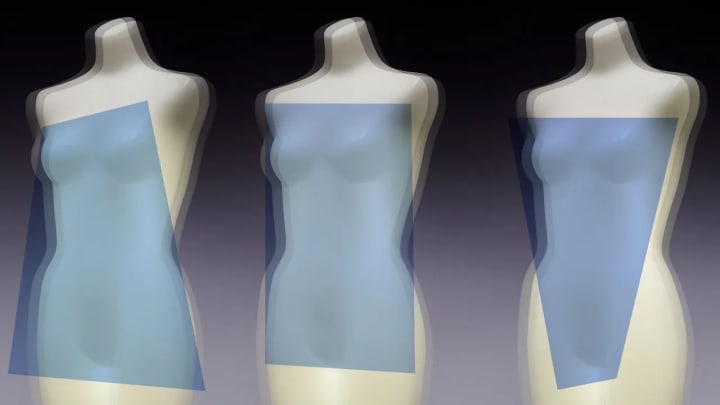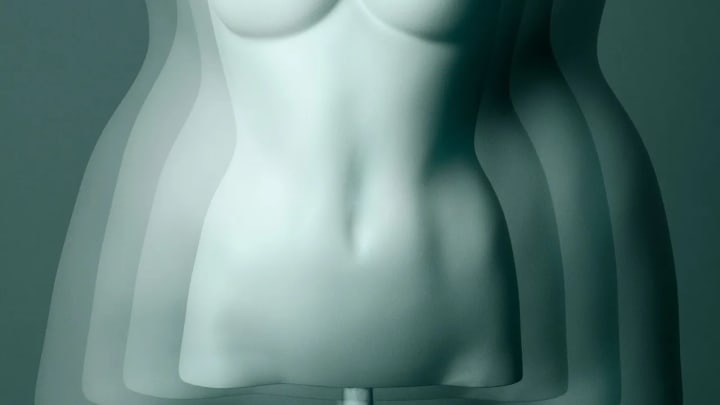How the pill changes your body shape
Many women believe that the pill can cause weight gain. Research hasn’t found this – but it has found that it can change body shape (and fat storage) in other surprising ways.

It’s been blamed for polluting our rivers, destroying our marriages and – ironically – killing our sex drives. It’s been called a conspiracy by the patriarchy. It’s even be accused of making women fancy ugly men. But for many women, one of the most off-putting charges against the contraceptive pill is that it makes us fat.
In fact, weight gain is the most commonly reported side effect of the combined pill – the most popular type, which contains both lab-made oestrogen and progesterone. This is why pharmaceutical companies list it on the packet.
But after several decades of research, there still isn’t any conclusive evidence that the effect is real. The largest review so far examined 49 studies of the combined pill and found “no large effect is evident”, but also that there wasn’t enough well-conducted research to be sure. The researchers found this is true no matter what type of progesterone the combined pill contained (for more on the different kinds of pill, check out this article). Other studies that looked at progesterone-only pills similarly have found little evidence of an effect.
You might also like these other stories in the Health Gap:
• The strange truth about the pill
• How the menstrual cycle changes women’s brains
• Why isn't this type of birth control used more?
Maria Gallo, an endocrinologist at Ohio State University who co-authored the review, believes our belief in the pill-weight connection is down to a natural human bias. People are experts at finding patterns all around us, even where there are none. The phenomenon, known as apophenia, is the reason we may find it easy to compare peppers to politicians, see the faces of Harry Potter villains staring down at us from the clouds, or read too much into past lottery numbers. We’re particularly susceptible to apophenia if we’ve been primed to expect a certain outcome – such as gaining weight after starting a new medication.
“It’s the same reason why there’s this idea that vaccines can cause health problems,” says Maria Gallo. “If you give them to a population, you’re going to have some people who have health problems, whether they’re linked to the vaccine or not.”

In the case of the pill, Gallo points out that the average person puts on just over a pound (half a kilo) of weight each year for most of their life, starting in early adulthood – which, incidentally, is when most women start using contraception. It may be reassuring to be able to blame this ‘weight creep’ on something other than overeating; last year she even caught women in the act of inventing weight gain after being fitted with the contraceptive implant.
Even so, it’s not all in our heads. Though large-scale reviews haven’t found that the pill causes weight gain, it can change a woman’s body shape and composition.
There are three big reasons for this, and they have to do with muscle, fluid retention, and fat.
Muscle in
Back in 2009, Steven Riechman, an exercise physiologist at Texas A&M University, discovered one surprising impact of the pill, entirely by accident.
Women on the pill had gained 40% less muscle than those who weren’t on it
At the time, he was researching how a person’s genetic makeup can affect their ability to grow their muscles through exercise. His research team put a group of men and women through 10 weeks of resistance training – slow, punishing exercises such as crunches and lifting heavy weights. Then participants were weighed to see if they had more muscle than they started with. The team also gathered information on various lifestyle factors so that they could make sure any gains were caused by genetics and not, for example, the medications they were on.
While they were doing this analysis, they discovered that women on the pill had gained 40% less muscle than those who weren’t on it.
“It jumped out as a pretty big impact,” says Riechman.
Eight women open up about the side effects they experienced from the pill. Watch the video below.
It’s well-known that men naturally have more muscle than women. The average man has 72lbs (33kg) of brawn, compared with a measly 46lbs (21kg) in women. This is partly just because men are taller and heavier overall, but that isn’t the whole story – as a percentage of overall body mass, men are about 38% muscle while women are 31%. This comes down to hormones: men have more ‘anabolic’ hormones running through their veins, which tell the body when to grow more muscle.

This includes an important but little-known steroid called DHEA. It’s secreted by the adrenal glands – cocktail sausage-sized organs which sit above each kidney – and is involved in everything from keeping bones strong to maintaining our immune systems.
The hormone used to be extremely popular with athletes, partly because of its extraordinary muscle-building power, and partly because doping with it was legal until fairly recently. Just in case you were getting any ideas, it also has many drawbacks, such as the tendency to cause liver damage and shrink a man’s testicles.
But women produce anabolic hormones too – and the team found that those on the pill had much lower levels of DHEA in their blood.

Even more intriguingly, the poor muscle gains weren’t found in all women on the pill, just those that contained a certain type of lab-made progesterone that likes to bind to the same protein.
“We’re pretty confident the progesterone is what’s causing this,” says Riechman. One possibility is that by competing for the same binding sites, the hormone may be blocking signals to grow more muscle. The results haven’t definitively proven the link, but if it does turn out to be real, surely women will want to know about it – especially in the light of recent fitness obsessions such as CrossFit and Instagramming your abs. “This study should absolutely be followed up. People are interested and we get calls fairly regularly about it,” he says.
Fat storage
And the pill may be changing women’s bodies in other ways, too. Just as it has an impact on the proportion of muscle in our bodies, it could be exerting subtle influences on fat – particularly where it is stored in the body.
The pill could be exerting subtle influences on fat – particularly where it is stored in the body
At puberty, oestrogen and progesterone are responsible for the development of typically ‘female’ characteristics, such as wider hips and larger breasts, largely by changing the way fat is distributed. The hormones are also often given to transsexuals for the same reason.
The womanly ‘hourglass figure’ emerges as different kinds of fat tissue respond differently to these reproductive hormones. For example, subcutaneous fat – the kind of chub that women carry around their thighs, hips and breasts – contains lots of oestrogen receptors.

It’s easy to see how, theoretically, changing a woman’s hormone balance could alter where her fat is stored. Some research has borne this out: one early study found that women on pills with higher levels of oestrogen tended to have pear-shaped bodies and more subcutaneous fat, though not necessarily more fat overall.
Cell swell
Finally, there’s the top menace of many women on the pill: bloating.
That icky, swollen feeling happens because oestrogen also affects the way the body metabolises water, by influencing the production of certain proteins in the kidneys. The end result is that the body retains more fluid than it usually would. This then seeps into fat cells, causing them to swell up. Because women tend to store more fat in their breasts, hips and thighs, these areas can expand the most.

Synthetic oestrogen is six to 10 times more potent than the natural kind
This also happens on a smaller scale in women who aren’t on the pill, during the week just before their period. But it’s exaggerated by the contraceptive because synthetic oestrogen is six to 10 times more potent than the natural kind, and because it’s taken nearly every day, which means the levels of both hormones are more constant.
So while the pill may not be leading to long-term weight gain, some women could still find that their clothes fit differently.
Fluid retention may also help to explain why some women report that the pill increases their cup size. There have been very few studies into the effect – understandably, most research tends to focus on breast cancer rather than size – but back in the 1990s a couple of Swedish scientists decided to take a look.
The contraceptive pill is known to increase a woman’s risk of developing breast cancer slightly, both while she’s taking it and in the 10 years afterwards. The researchers wanted to know whether this might be because these women have larger breasts; there’s an inherent risk in having (or growing) more cells, which is one reason tall people tend to be more susceptible to cancer.
To find out, the team tracked the monthly cycles of 65 healthy women who either were on the pill, used to take it, or had never taken it. They found that not only did pill users have significantly larger breasts overall, but they were especially large at certain times of the month. Women who had previously been on the pill had an average-sized bust.

The team didn’t check the women’s chest measurements before they started taking the pill, so it could be argued that these women had always had larger breasts. However, it seems likely this was due to the contraceptive pill, because their breast sizes weren’t linked to the normal factors you’d expect – such as their height, BMI, or body weight – as in the women who weren’t on the pill.
The hormones in the pill are actually causing women’s breasts to grow
Exactly how this happens remains a mystery. The breast expansion could just be swelling from fluid retention, but another possibility is that the hormones in the pill are actually causing women’s breasts to grow. For example, the burst of growth that happens each month, and is necessary to maintain a constant size, could be lasting a bit longer. This would lead to more tissue overall – and explain the heightened cancer risk.






Comments
There are no comments for this story
Be the first to respond and start the conversation.